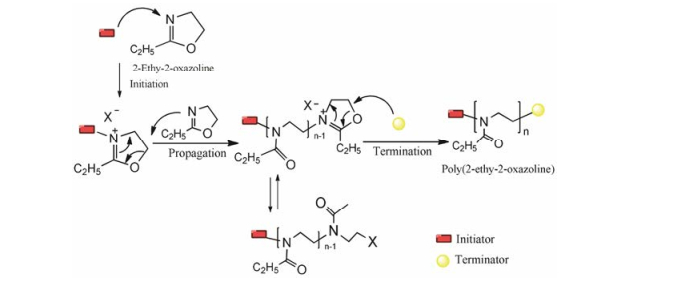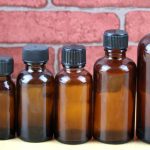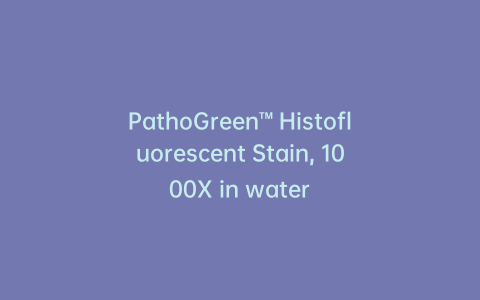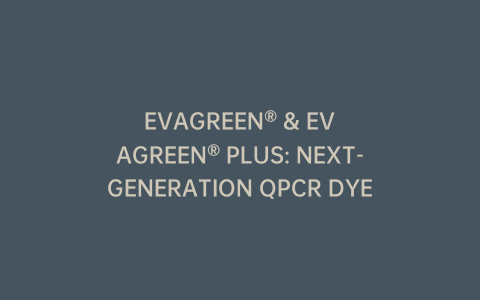Definition
PEOz (Poly(2-ethyl-2-oxazoline)) is a hydrophilic long-chain polymer synthesized by living cationic ring-opening isomerization polymerization of 2-ethyl-2-oxazoline with the characteristics of low toxicity, biocompatibility, flexible chain and easy to modify. As a potential PEG substitute, it has similar hydrophilic and compliant properties to PEG. The synthesis of PEOz is simple and controllable, and its structure is easy to functionalized without hindering cell uptake. In addition, owing to its pH sensitivity, PEOz can achieve endosome escape. Recently, PEOz has been widely used in drug delivery systems and for protein separation. Apart from that, it can also be applied to the preparation of heart stents to stimulate vivo tissues and explore its compatibility in combination with other polymers.
Synthetic Method
PEOz can be prepared by amide cyclization, reaction of β-alkanolamines with carboxylic acids or carboxylic esters, or from nitrile. With active chemical properties, it is widely used in the synthesis of various polymers as monomers. PEOz can be dissolved in various solvents such as chloroform, acetonitrile, ethanol, methanol and water due to its low viscosity and good solubility. Compared with the traditional heating ring-opening polymerization, its reaction speed can be increased 360 times without changing the polymerization reaction mechanism under the induction of microwave heating. The monomer polymerization can be achieved in a few minutes, which greatly shortens the reaction time and speeds up the commercialization progress of PEOz. The preparation of PEOz adopting cationic ring-opening polymerization can effectively control the polymerization degree and obtain low dispersion polymers in diverse molecular weights. In addition, by selecting the initiators and terminators, and introducing the functional groups with different properties, such as hydroxyl, carboxyl, amino and sulfhydryl groups, to the polymer ends, the modifiability of the materials can be improved.

Reaction Mechanisms
Synthetic Process
1. Monomer Selection: PEOzcan be synthesized using various types of 2-oxazoline monomers, each with different properties.
2. Polymerization Reaction:
Initiation: The polymerization process usually starts with an initiator. Common initiators include bases, acids and other chemicals that can activate the ring-opening polymerization of the oxazoline monomers.
Ring-Opening Polymerization: The monomer’s ring opens, and the active end of the growing polymer chain reacts with additional monomer molecules. This process is typically controlled to achieve the desired polymer length and molecular weight.
3. Reaction Conditions:
Temperature and Solvent: The polymerization is carried out under controlled temperature and solvent conditions. The choice of solvent and temperature can influence the reaction rate and the properties of the resulting polymer.
Catalysts: In some cases, catalysts may be used to enhance the polymerization process.
4. Workup:
Quenching Reaction: Once the desired polymerization degree (molecular weight) is achieved, the reaction is quenched using appropriate chemicals.
Purification: The crude polymer is often purified through processes like precipitation, filtration, and drying to remove unreacted monomers, initiators, and other impurities.
5. Characterization: The synthesized PEOz should be characterized to determine its molecular weight, polydispersity and other properties. Techniques such as gel permeation chromatography (GPC), nuclear magnetic resonance (NMR) spectroscopy and Fourier-transform infrared (FTIR) spectroscopy can be used.
6. Modification and Functionalization (Optional): After synthesis, PEOz can be modified or functionalized to introduce specific properties or chemical groups to suit its intended application.
Physical and Chemical Properties
Biocompatibility: Owing to the aliphatic side chain and skeleton structure similar to natural peptides, PEOz has good biocompatibility and blood compatibility. It is a safe drug carrier material. Nanoparticles or drugs modified by PEOz have increased stability, reduced surface protein adsorption and extended systemic circulation time.
pH Sensitivity: The unique tertiary amide structure in the PEOz main chain endows PEOz with a pKa which is close to physiological pH. The pKa value decreases with the increase of polymerization degree.
Applications in Drug Delivery Systems
As nano-transfer material: PEOz, as a Ph-sensitive hydrophilic material, is able to increase the systemic circulation time and cell intake of the nanodrug delivery systems to achieve environmentally sensitive drug release. In addition, due to its pH sensitivity and strong terminal modifiability, PEOz can be used to achieve active targeted drug delivery at tumor sites and increase the uptake of nanoparticles by cells.
Protein drug delivery: Protein drugs are easily deactivated by hydrolysis, resulting in short half-life and low bioavailability. By modifying their surfaces with hydrophilic polymers, there in vivo stability can be increased without affecting their activity.
Gene delivery: Gene therapy is a common treatment method for diseases caused by genetic defects or abnormalities. The naked gene drug has poor cell targeting ability, low transfection efficiency, and it is easily degraded by ribozyme, so a suitable carrier is needed. PEI is a cationic vector with high transfection efficiency, which can effectively deliver genes. However, it is highly cytotoxic, which can be reduced by modifying with hydrophilic polymers. The preparation of PEI using PEOz hydrolysis under high temperature and acid conditions, and the gene delivery in PEOZ-PEI block copolymer, which is a partial product of PEOz hydrolysis, can not only maintain high transfection efficiency, but also reduce the cytotoxicity of PEI.




